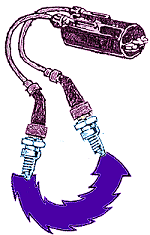  ® ®
|
Waste spark |

Most riders have heard of the "waste spark" ignition configuration. And it is a configuration, by the way, not a system. That is, the name does not describe one of the seven historically used powersports ignition systems. It could be and has been applied to any of them. In the waste spark configuration, cylinder A will be at top dead center compression and will have an air/fuel mixture to ignite while cylinder B will be at top dead center exhaust where there is no mixture present and thus the spark in that cylinder is ineffective, or "wasted". Then 360 crankshaft degrees later, A is the waste cylinder and B is the combusting one. And another 360 and we're back to A combusting and B not. All the waste spark arrangement is, is a way to make one ignition coil function for two cylinders. It's manufacturer economizing, in other words.
However, don't think that makes it an inferior configuration. It has been used in a lot of cars, even to this day, in addition to virtually every multicylinder motorcycle until recently. The only downside is a theoretical one, that is, one that would make a good college paper but which is never experienced in the real world. To make both spark plugs to fire at the same time, the coil's two plug wires are connected in a series arrangement. Therefore, one spark plug will fire from its positive electrode to its negative electrode, and the other from its negative electrode to its positive electrode. The plug doesn't care, and neither does the engine. However, a spark plug's positive electrode has less surface area, making spark jump the gap easier than it will from the broader, blunter negative electrode. Thus the reverse-firing plug could be said to take more voltage to fire. While this is theoretically true, in practice the less cooperative plug actually slightly reduces the readiness of both plugs to fire. This is an attribute of series electrical connections: voltage is the same throughout (Ohm's Law). But this is not a handicap. An ignition coil always sends the spark plug much less voltage than it is capable of; it has much in reserve and is not at all affected by the waste spark arrangement.
You may have heard of the Denso U-Groove spark plug and its copy the Splitfire plug. As is typical with advertising, these plugs' promotion material once described them as "hotter" or better performing. This ignored the truth behind their development. In reality, the groove or notch in the plugs' negative electrode is an attempt to make it have a smaller, sharper surface from which to fire when the plug is operated in its reverse direction, thus reducing its voltage requirement. A good idea, but it has been proved that the design delivers no real-world advantage. Because reverse firing just does not affect engine performance. Those engineers knew what they were about.
Series electrical circuits have other potential drawbacks, as long as we're talking electrical theory. The Christmas tree lights of our fathers and grandfathers days were wired in series. When one bulb failed, all the others lacked voltage and also quit. This can happen to spark plugs too when they are wired in series. If anything happens to keep one plug from firing, this can stop the other plug from firing. And in severe cases, this can result in the coil being destroyed as it arcs internally trying to complete the circuit. Though important to keep in mind when troubleshooting, it doesn't happen often. Troubleshooting is affected because most people think one plug not firing in a waste spark configuration would take out the other plug too. But it doesn't necessarily.
|
|
More like this: |
|
Last updated June 2025 Email me www.motorcycleproject.com My bio © 1996-2025 Mike Nixon |